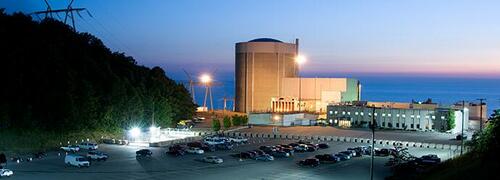Michigan Going to Need More Gas Electrical Generation. Another Nuclear Plant Closes: Get Ready For Electricity Shortages
Authored by Robert Bryce, host of the Power Hungry Podcast, executive producer of the documentary, “Juice: How Electricity Explains the World,” and the author of six books, including most recently, “A Question of Power: Electricity and the Wealth of Nations.”
America’s electric grid is being mismanaged and consumers will pay a heavy price for that mismanagement...

https://www.zerohedge.com/energy/another-nuclear-plant-closes-get-ready-electricity-shortages
More evidence of that came with the recent closure of the Palisades Power Plant in Michigan. The 811-megawatt nuclear plant was shut down on the same day that the North American Electric Reliability Corporation (NERC) issued a report saying the U.S. electric grid doesn’t have enough generation capacity and that blackouts are almost certain to occur across the country this summer.
In particular, NERC noted that the Midwest is facing a capacity shortfall that could lead to a “high risk of energy emergencies during peak summer conditions.” Palisades was located in the heart of the Midwest, immediately adjacent to the area served by the Mid-continent Independent System Operator (MISO), the region that NERC identified as being particularly short on juice. NERC said the MISO region has 3,200 megawatts less generation capacity this summer than it did in 2021. Despite this loss of generation capacity, NERC expects demand in the region to increase by about 1.7 percent this summer and warned that “extreme temperatures, higher generation outages, or low wind conditions” will mean that MISO will have a “higher risk” of “load-shedding to maintain system reliability” — the industry’s preferred term for rolling blackouts.
In a phone interview, Meredith Angwin, author of the 2020 book, “Shorting The Grid,” told me, “It is shocking to me how people can pretend this isn’t a problem. NERC just said the Midwest is headed for trouble this summer because the region doesn’t have enough reliable generation — and yet, they are closing Palisades. It doesn’t make any sense.”
Palisades was a zero-carbon workhorse. As Tim Cavanaugh of the Mackinac Center for Public Policy explained recently, Palisades was producing about 7 terawatt-hours of juice per year. That’s more energy than is generated by all the wind turbines in Michigan. It’s a key comparison because the backlash against the wind industry has been fierce in Michigan. Among the latest examples, last month the town board in Fulton Township voted unanimously to reject a project proposed by Chicago-based Invenergy that would put several dozen wind turbines in and around the township.
As I reported last month, the planned closure of Palisades was known for years and several politicians, including Energy Secretary Jennifer Granholm and Michigan Gov. Gretchen Whitmer, have said they wanted to prevent the closure. On April 20, Whitmer said, “Keeping Palisades open is a top priority.” She hoped to tap some of the $6 billion available in the Department of Energy’s Civil Nuclear Credit Program, created through the bipartisan infrastructure bill that President Biden signed into law in November. In a letter to the Department of Energy, Whitmer said stopping the closure of Palisades would “allow us to shore up Michigan’s energy supply to prevent price spikes on working families and small businesses.”
But, since the plant was closed on May 20 — 11 days earlier than expected because of a mechanical problem — Whitmer’s office has not issued any statements. Nor has there been any public statement from the Biden administration about trying to rescue the plant, whose decommissioning could take two decades. Biden’s climate envoy, John Kerry, repeatedly has called climate change “an existential threat.” If he believes that’s true, why hasn’t Kerry raised a stink about the Palisades closure?
There’s no doubt that the plant’s closure will result in more greenhouse gas emissions. When nuclear plants close in the United States, they are replaced by gas-fired generation. That happened in New York after the closure of the Indian Point Energy Center, and in Vermont after the premature shuttering of Vermont Yankee. The closure of such plans increases electricity costs because generators must burn more natural gas to produce power and gas prices are soaring.
Just like last year’s premature closure of the Indian Point, the loss of Palisades, which has been operating safely since 1971, is an inexcusable government failure. By any relevant metric — climate action, energy security, or resilience — the loss of Palisades is a blunder that could have and should have been avoided because it will further weaken our electric grid. The grid is the Mother Network for all of our critical systems: health care, GPS, communications, traffic lights, water, and wastewater treatment. Essayist and podcaster Emmet Penney had it right when he declared last year that “there is no such thing as a wealthy society with a weak electrical grid.”
In short, the closure of the Palisades Power Plant will increase emissions, reduce energy affordability, and hurt the resilience and reliability of America’s electric grid. That’s a lousy quadfecta.
Robert Bryce is the host of the Power Hungry Podcast, executive producer of the documentary, “Juice: How Electricity Explains the World,” and the author of six books, including most recently, “A Question of Power: Electricity and the Wealth of Nations.” Follow him on Twitter: @pwrhungry.